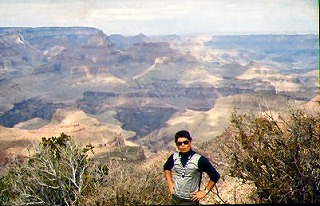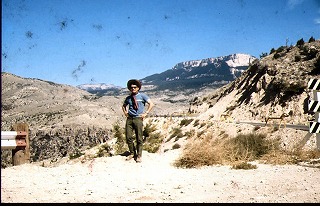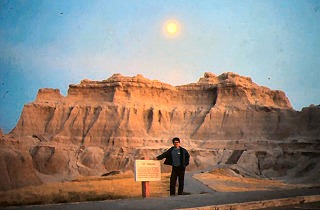| Part 10-1 Ala Carte (1) |
|
| Eid ul-Adha (Sacrifice Feast) |
|
|
Talking about the religions popular in Japan, Buddhism, Christianity and
Islam would be indispensable.
According to the book "The three largest religions in the world" (New Kawade-shobo Co.), the believers in Christianity are about 2 billion, Islam about 1.2 billion and Buddhism 400 million.
The book says, "Islam is not so popular in Japan, but actually 20%
or one fifths of the world population are its believers."
Speaking of the holidays based on religion, everybody knows Christmas in
the Christian countries. In Japan Christmas sale and the party on the Christmas
eve are more popular than Christmas itself, when believers and such people
seem to celebrate the day.
Easter, a festival and holiday celebrating the resurrection of Jesus on
the 3rd day from the dead, is not so popular as Christmas in Japan. It
is a movable feast, on April 4 this year.
Thanksgiving Day celebrated in the US and Canada must be applicable to
Labor Thanksgiving Day in Japan, with no direct relationship with Christianity.
It is held on November 23 in Japan, while in the US on the 4th Thursday
of November, and in Canada on the 2nd Monday of October.
On each day in both countries, a lot of turkeys are sacrificed. Hence the
day is called Turkey Day in the US. Before we knew it, the misfortune of
turkeys was performed on Christmas Day, too. The Japanese people have been
imitating this ceremony, and turkeys or chikens as their substitutes are
on the dinner tables.
Though in the Buddhist country Japan, there is no such special holidays
or religious events around me.
I know April 8 is the celebration day of Buddha's birthday, but I have
no more knowledge than "amacha-de-kappore" (Japanese comic dance).
|
|
|
The most important festival of Islam is said to be a Muslim day of feasting
at the end of Ramadan. It is held for 3 or 4 days from the 1st day of the
10th month, the next month after Ramadan month. The day is different every
year because it depends on the Islamic calendar.
According to the book "The Three Greatest Religions of the World"
(New Kawade-shobo Co.), generally, Muslims, dressed up for good appearance,
gather together in a mosque or a hall, listen to the preach and finish
their mass worship.
The second largest event of Islam is Sacrifice Festival. It is said that
this festival is held for 3 or 4 days from the 10th day of the 12th month,
the pilgrimage month of the Islamic calendar. That was the reason that
the influence of Sacrifice Festival we met at Fez lasted until leaving
Morocco.
The book previously mentioned says, "Since this month is during the
pilgrimage, the Sacrifice Day is the festival to eat domestic animals.
Some part of the food is given to poor people. Sacrifice is the domestic
animals."
It was my first time to see the sight of Sacrifice in Morocco, so I mistakenly
thought an animal equals a sheep. Later, I knew it is a sheep and a cow
in Turkey, and in Indonesia a cow and a goat. What about in other Islamic
countries?
|
|
|
The origin of this festival is as follows.
The Old Testament is shared by Christianity, Islam and Judaism, regardless
of some sort of differences of interpretation.
Sacrifice Festival is based on the Old Testament.
When Ibrahim (Abraham) was about to make Ismar, the first son (Isaac, the
second son in Christianity) a sacrifice to God, he heard the revelation
"I understand your faith. Sacrifice a sheep instead.
It is this part.
|
|
|
According to Mr. Abdelilah, a guide, "One family sacrifices one sheep
in Morocco, so about one million sheep must be lost around the day in this
country."
The price of one sheep is about 250 American dollars and the income of
one average family is 400-500 dollars a month. So, the expense of an average
family must not be ordinary. (Please allow me if my understanding is wrong.)
It is well imagined that most of the poor sheep are males. What kind of
meals do they go to?
The beginning is a barbecue of internal organs. Then tajine, couscous and
sausage at last.
Why didn't we see mutton at all with any meal? I understood then that it was because mutton is more expensive than beef even usually and the period of our trip was just during the Festival.
|
|
| The History of Morocco |
|
| How much have I known about Morocco? It is a country of the northern part
of African Continent, Sahara Desert, Casablanca, ... Undependable at all.
This country has become familiar to me at last through the cities, the
ruins and the people I caught a glimpse of during this trip.
It is a kind of "Blind men and a big elephant" so to speak, but
there were several things to make me nod.
I have been interested in the history of this country until now. The brief
chronicle of Trapics's guidebook is helpful to my understanding. Though
understanding only some of them even now, it is true it has been useful
to me through the trip.
|
|
|
|
History of Morocco |
|
|
|
BC
146 |
|
The 3rd Punic War ends. Under the rule of Rome |
AD
200-300 |
|
Volbilis prospers as a territory of Rome |
| 439 |
|
The invasion of the Vandals |
| 534 |
|
Byzantine Empire defeats the Vandals |
| 703 |
|
The Arab invades Morocco |
| 788 |
|
Idrisid Dynasty formed. Fez as a capital later. |
| 859 |
|
Andalus Mosque in Fez completed |
| 1055 |
|
Almoravid Dynasty formed. Marrakech as a capital |
| 1130 |
|
Almohad Dynasty formed |
| 1199 |
|
Hassan Tower in Rabat, construction abandoned incomplete |
| 1269 |
|
Marinid Dynasty formed. Fez as a capital, again |
| 1549 |
|
Saadi Dynasty formed. Marrakech as a capital |
| 1666 |
|
Alaouite Dynasty, the present dynasty, formed. Meknes as a capital |
| 1732 |
|
Bab el Manour in Meknes completed |
| 1912 |
|
Treaty of Fez. To the territory of France. Rabat as a capital |
| 1956 |
|
Become independent from France |
| 1961 |
|
King Hassan 2 ascends the throne |
| 1993 |
|
The Mosque of King Hassan 2 completed |
| 1999 |
|
Mohammed 6 ascends the throne due to the death of King Hassan 2 |
|
|
|
|
We saw part of the glory of Roman Empire at Volubilis Ruins and was surprised
to know the influence of Rome here.
On the other hand, what is the Berber, an indigenous people? "Berber"
is said to mean people with no understanding of words in Greek. They are
called "Barbarians" in English. They must be unpleasant.
They are said to like "Amazigh" for them, meaning "People
of noble origin" or "Free people".
Maybe by chance, Mr. Abdelilah, a total guide, Mr. Majid, a guide in charge
of Marrakech and the driver were Berber people. They were all cheerful
and got a joke.
Then, what about the Arab, half of Moroccan people?
I did not hear any story of a conflict between different races. How were
they fused? How did Islam take root here?
The capitals often moved to and fro by the change of the dynasties. I
was vaguely aware of such background at each Medina.
I have a strong feeling that I flew to the westernmost point of the sunset
and travelled around a peaceful country of mostly the Berber people who
don't want any fight and have continuously been influenced by outside pressure.
Furthermore, there are several phases not written especially in the chronological table and I paid attention to.
They are:
The unique landform like Sahara Desert of the south and the three mountain
ranges crossing the center of the country.
The Mediterranean Sea bounded on the north and the Atlantic Ocean bounded
on the west.
It is within a stone's throw to Spain, for which, as I mentioned before,
it has complicated historical background.
The influence of France to anything can be easily understood.
I got interested in this country much more, thinking the threads of warp
and weft are woven between the lines of the brief chronology.
|
|
| Morocco and Western Movies |
|
|
Various places in Morocco are made use of as the stages of movies. It is
natural. The large cities and Medinas must surely be suitable, and so,
probably I have already seen such places in a lot of movies.
But it must be very difficult to make a movie with hero characters at
Medinas or such crowded places.
Besides the filming of the large cities like Casablanca and Rabat would
be satisfied by doing it at other cities in Europe and the US.
Morocco's charm is in the wild nature. Also it is in the people and the
villages making full use of such environment.
These circumstances would excite the movie makers saying like:
"This scene must be done in Morocco." "This scene has to
make use of the place in Morocco." "This stage is much better
at this place in Morocco." "....."
I now remember the High Atlas Mountains, from Marrakech down to the south
for Ouarzazate. The road over the mountains was thrilling. Rather than
my impression, the mountains of the wide view beyond would be fascinating
to film-makers. All of the mountains are bald and the surfaces are mostly
reddish-brown with some parts of yellow, light green, clouded, pure white,
...
Cliffs are scary. There were large rocks just about to fall everywhere,
which made me wonder why they wouldn't fall down. If one earthquake ....?
The same views came to my eyes during driving over Moyen Atlas from Erfoud
north to Fez.
This may have been mentioned before somewhere.
Ait Benhaddou near Ouarzazate is already famous for the stage of various
movies like "Lawrence of Arabia", "Gladiator" and "The
Jewel of the Nile". This Casbah appears somewhere on the three movies,
no doubt.
Ouarzazate itself is said to be a sister city of Hollywood. We saw 2 movie
studios near Ait Benhaddou.
The wilderness of Casbah road from Ouarzazate to Erfoud must be some stage
of films.
|
|
|
Todgha Gorge over the side road from Casbah highway. It is surrounded by
the high, steep reddish-brown rock cliffs for several hundred meters. Surely
it is said to be admired by rock climbers. Must be in some scene of movies.
Sahara Desert was the stage of "Patton" and "Sahara".
I suppose there are still some other movies. It is a lie, but even if I
say this desert was the stage of "Planet of Apes", no one would
disagree, I believe.
|
|
|
The stage of "The Sheltering Sky" is said to be Ouarzazate. It
is probably such a movie that the couple, tired of their married life,
travel to Africa. I have not seen it yet.
Apart from that, I do not hesitate to say that all the above places are
the most suitable for Western, adventure and action movies. On the contrary,
I thought they were not suitable for melodrama or romance movies.
In the US, movie producers seem to have a hard time to shoot such a Western
and action movies on location like "Indiana Jones" series. In
this point, Morocco would be counted on more and more as where the places
for a movie and TV are located with the eastern area and the area along
the Mediterranean Sea. Someone may say, "I already know it. It is
ongoing now. You'll see."
|
|
|
I feel I have ever visited such and such places in mind in spite of the
first time. As a fan of Western movies, there were many places where cawboys
would be matched during the trip there.
The Western movies that came out to me then were the following, all of
which I admit as masterpieces.
|
|
| All the works of John Ford, including "The Horse Soldiers" |
| John Sturges "Gunfight at the O.K. Corral" "The Magnificent
Seven", Sam Peckimpah "The Wild Bunch", Howard Hawks "Rio
Bravo", William Wyler "The Big Country", George Stevens
"Shane", Fred Zinnemann "High Noon", Clint Eastwood
"Unforgiven", Marlon Brando "One-Eyed Jacks" |
|
|
|
| - - - - - |
|
Turn the globe, and you will understand Morocco is in the same latitude
as the south of USA. Both of them are wildernesses, mountains, deserts,
..., and their climate and geographical features are almost similar.
As I mentioned the following before somewhere;
40 years ago, I studied at Penn State (Pennsylvania State University) for
one year. Making use of a long summer vacation, three of us, two guys and
I, crossed the American Continent for 28 days on a beat-up Mustang with
a tent on top.
State College, a college town in the center of Pennsylvania State, as the
starting point, we headed for the West Coast and wanted to make a round
trip to Santa Monica in the suburbs of Los Angeles.
We went along the south route and came back along the north route. The
total mileage was 14,165 km.
Our old Mustang without air-conditioning had a couple of trouble on the
way, including a flat tyre, engine breakdown, but it managed to run the
whole distance.
The following is the States we went past.
|
|
| To |
| Pennsylvania → Ohio → Indiana → Missouri → Illinois → Oklahoma → New Mexico
→ Arizona → California |
|
| From |
| California → Nevada → Arizona → Utah → Colorado → Wyoming → South Dakota
→ Nebraska → Iowa→ Ohio → Pennsylvania |
|
|
|
| I am going to show several pictures ostentatiously as follows, all of which
I actually thought to be similar to the sights in Morocco. |
|
 |
| Grand Canyon |
|
 |
| Wyoming |
|
 |
| Painted Desert |
|
 |
| Badlands |
|
Other Pictures
(in the US, 40 years ago) |
|
| Reading: 23:33 |
|

